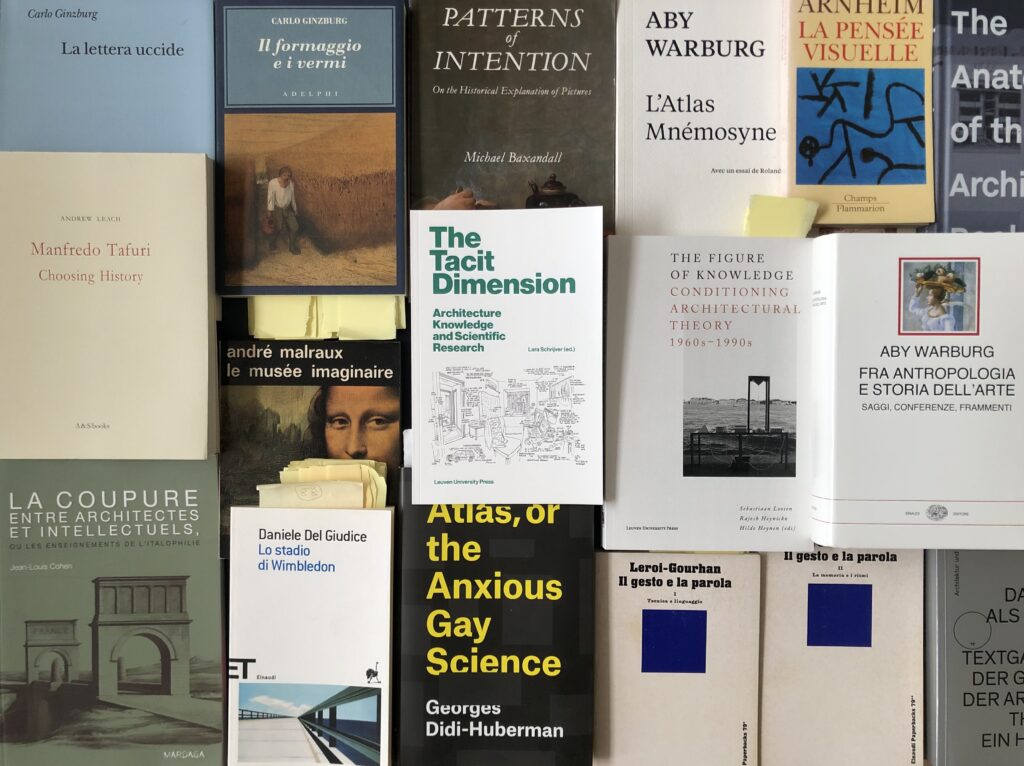Return to archive
title
TACK Talk #3: Concepts of Authorship in Architecture
authors
Christoph Grafe Peg Rawes
The third round of the TACK Talks was hosted by the Institut für Kunst und Architektur (IKA) at the Akademie der Bildenden Kunst Wien (ABKW) and organised as a series of discussions between two or three academic partners of the research project who offered their understanding and vision of the tacit dimensions of architectural knowledge.
The title and theme of the research project, and consequently of the lecture series, derived from the idea of “tacit knowledge”, which was introduced by Michael Polanyi and Gilbert Ryle starting in the 1950s. They addressed the fact that there is a whole range of forms of knowledge that we learn and apply implicitly, mainly through immediate physical implementation, without being able to explain them precisely. For Polanyi, this meant that, “we know more than we can say”. (Riding a bicycle is often cited as an example of “knowing how” rather than “knowing that”.) Architecture, and especially the architectural design process, fits well into this thesis. For although many architects make great efforts to explain and (post-) rationalise their design approaches, the actual process remains unknown, even when working in a team. The physical activity of sketching, drawing, building working models, etc. is individual and collective at the same time, since in addition to the subjective choice of forms and structures, there is also recourse to the familiar, because it is easy to communicate: processes, images and jargon, which in turn also promote habitual prejudices.
It would be easy to say that this implicit knowledge need not become explicit. This attitude has in fact intensified, especially as part of modernist criticism from the 1970s onwards: architecture should be autonomous again, should be art, and should do without rational explanatory patterns. But there are some points that, conversely, should make interest in tacit knowledge grow. First of all, of course, there is the increased use of digitalisation tools in the design process, which promotes rationalisation. If the only physical activity in designing is clicking a mouse, can something like tacit knowledge emerge? And wouldn’t we need it? By whom and how is architecture then explained? This leads to the second point. In times of crisis, construction should critically engage with the public. Enigmatic explanations of beautifully drawn architectural visions are no help. Conversely, an artistic process does not have to be described prosaically. Instead, awareness of and sensitivity to other kinds of knowledge should be communicated in order to be able to promote precisely the creative power of unconventional projects. And furthermore, research into “tacit knowledge” in architecture would at the same time be a contribution to “artistic research” in architecture, a field that is yet obscure and needs to be explored in greater detail, which task the ten doctoral students involved in the research project took on in particular.
Prof. Dr. Christoph Grafe, Bergische Universität Wuppertal
The concept of authorship, and its association with a single (European, male, heterosexual) individual, is ingrained in the complex of tacit assumptions about what constitutes a work of art and its production. Perhaps somewhat ironically it is applied also to architectural works of art, which are, by definition, the product of collective endeavours. The specific nature of the processes of designing buildings and getting them realised – the realities of an essentially situated form of cultural practice – may even be an explanation for the persistent emphasis on the individual in whose heroic vision the original idea for the work resides. The need to establish and exert authorial authority in a highly volatile field of power relationships between financiers, officials, builders and users requires a set of tacit strategies of persuasion, of forging a temporary collective and of coercing others to follow in acts of self-exploitation. The question is, however, if in our current circumstances the concept of individual authorship is not a cul-de-sac, preventing the processes of invention and innovative thinking that would be necessary for addressing a practice that is more collaborative than it has been in the past and which operates in a culture that professes to question rather than valuing authority. Is there not also a need to conceptualise, regain and possibly invent alternative notions of authorship which may be more diffuse, but still no less effective in producing works of art (aka significant cultural statements) in architecture? What would this mean for the modus operandi of those who engage with these creative and social processes, and how might the deep intellectual and emotional ownership that is a precondition for conceiving and making architecture be retained, framed and even intensified in new organisations of labour for this old discipline, and for establishing innovative communities of practice?
Prof. Dr. Peg Rawes, Bartlett, UC London
Communities of Tacit Knowledge share value systems. The norms and standards within the practice of architecture are, however, also informed by the culture within which they emerge and operate. Unravelling the intricate relations between contextual (culture-based) value systems and the disciplinary values of architecture is central to the IRP ‘Values’.
Peg Rawes will discuss tacit knowledge in architectural authorship with respect to current political, ethical and environmental values.




